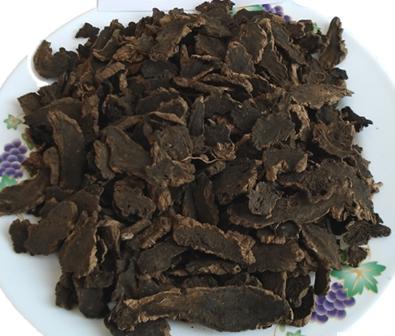Figwort Root
Naming
Xuan Shen (Radix Scrophulariae)——Shen Nong Ben Cao Jing (Shen Nong’s Herbal)
Origin
The root of perennial herbaceous plant Scrophularia ningpoensis Hemsl of family Scrophulariaceae.
Location
Yangtze River Valley as well as Shaanxi and Fujian provinces
Harvest
Collected in winter when its stem and leaves become withered.
The actual smell and taste
Special smell as burnt sugar, bitter and slightly sweet.
Best quality
Big branch, fine and compact bark, solid texture, black flesh.
Processing
Sliced and unprocessed.
Property
Bitter, sweet, salty, light cold; heart, stomach, kidney, lung meridians entered.
Actions
Clear heat and cool blood, purge fire, remove toxicity, nourish yin for lowering fire.
Indications
A. Heat entering nutrient-blood in warm diseases
Its action of heat-clearing and blood-cooling is quite similar but a little bit weaker than that of Di Huang, but it has the actions of body fluid-promoting and dryness-moistening by means of nourishing stomach yin; and it can purge fire and remove toxicity although no action of stopping bleeding, so it is indicated for syndrome of heat entering nutrient-blood in warm disease. For heat entering nutrient-blood systems manifested as nutrient-yin deficiency symptoms like fever aggravated at night, crimson tongue and rapid pulse, it is often combined with other nutrient-clearing and blood-cooling herbs, for example, Raw Di Huang, Lian Qiao, Dan Shen and so on, as in Qing Ying Tang from Wen Bing Tiao Bian.
In addition, with the actions of clearing heat and cooling blood as well as purging fire and removing toxicity, it is commonly indicated for syndrome of interior invasion by heat-toxicity in warm diseases which results in dual blaze of qi and blood manifested as coma, delirium, and macula. It is often combined with herbs of clearing heat and cooling blood and herbs of cooling blood and clearing heart so as to mutually take effects of clearing both qi and blood, for instance, Shi Gao, Zhi Mu, Shui Niu Jiao and so on in Hua Ban Tang from Wen Bing Tiao Bian.
B. Swollen and sore throat, sores and abscess, scrofula and sucutaneous nodule
It can purge fire, remove toxicity, nourish yin for lowering fire, and excels in alleviating sore throat, so it is the commonly used herb for sore throat no matter caused by toxicity-heat accumulation or up-flaming of deficiency-fire. For excessive interior heat manifested as swollen and sore throat, it is often combined with toxicity-removing and sore throat-alleviating herbs, for instance, Huang Qin, Jie Geng and Ban Lan Gen in Pu Ji Xiao Du Yin recorded in Dong Yuan Shi Xiao Fang. For dry and painful throat caused by up-flaming of deficiency-fire, it is often combined with yin-nourishing and dryness-moistening herbs. For example, Mai Dong and raw Di Huang in Yang Yin Qing Fei Tang from Chong Lou Yu Yao (Pairs Building Jade Key).
With the actions of purging fire and removing toxicity, cooling blood and nourishing yin, it can also be used in treating both syndrome of heat-toxicity manifested as sore and abscess with swelling pain, and syndrome of yin deficiency with effulgent fire and accumulation of phlegm and fire manifested as scrofula and sucutaneous nodule. For the former syndrome, it can be combined with heat-clearing and toxicity-removing herbs which excel in curing abscess, such as Jin Yin Hua, Lian Qiao and Pu Gong Ying, etc.; while for the latter syndrome, it should be combined with phlegm-eliminating and nodulation-dissipating herbs, for example, Zhe Bei Mu and Mu Li, as recorded in Xiao Lei Wan in Yi Xue Xin Wu.
C. Yin deficiency with body fluid consumption, strain cough and bone-steaming
It has the actions of nourishing kidney, lung and stomach yin, and excels in lowering deficiency heat, so it is widely indicated for yin deficiency syndrome of kidney, lung and stomach, and should be combined with yin-nourishing herbs corresponding to related organs. For syndrome of kidney-yin deficiency manifested as bone-steaming tidal fever, it should be combined with herbs for nourishing kidney-yin, lowering fire and relieving bone-steaming, such as Raw Di Huang and Zhi Mu, etc. For syndrome of lung-yin deficiency or both lung and kidney yin deficiency manifested as strain cough and hemoptysis, it should be combined with herbs of nourishing yin and moistening lung, for example, Bai He and Mai Dong as Bai He Gu Jin Tang from Yi Fang Ji Jie. For syndrome of stomach yin-deficiency manifested as diabetes, polydipsia, thirst due to body fluid consumption, constipation due to intestine dryness, it is often combined with herbs of nourishing yin and moistening dryness to mutually take effects of promoting body fluid, relieving thirst, moistening intestine and relax bowels, for example, Raw Di Huang, etc. , as in Zeng Ye Tang from Wen Bing Tiao Bian.
Dosage and Administrations
Decoct 10~15g.
Cautions
It's contraindicated in cases of diarrhea due to spleen deficiency. It is antagonistic to Li Lu.


